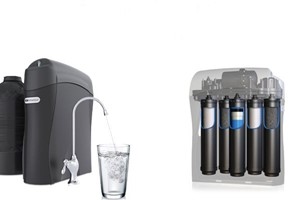WHAT IS REVERSE OSMOSIS?
Reverse osmosis, or RO, is a water treatment process in which water passes through a semi-permeable membrane. Reverse osmosis is known for producing great-tasting pure water and being highly effective for contaminant removal.
HOW DOES REVERSE OSMOSIS WORK?
The reverse osmosis process uses a semi-permeable membrane to separate water from contaminants. “Semi-permeable” means that some things can pass through, and others can’t. A familiar example would be your furnace’s air filter. A key difference in semi-permeable membranes for water treatment is that they allow passage based on the size of the particle and its molecular charge. Typical air filters separate the contaminants exclusively by size. Holes, or pores, in the RO membrane are just big enough for the passage of a water molecule. Even small particles such as tobacco smoke or paint pigments are too big to flow through an RO membrane. At this point, because the membrane only lets certain molecules pass through, there is some waste. The waste, a highly concentrated solution of contaminants, is sent to the drain. You are left with virtually contaminant-free, clean water that makes it through the membrane. This is called a permeate stream, or as we like to say, great tasting, filtered water.
Reverse osmosis technology relies on pressure to push the water molecules through the membrane. Water pressure varies by water source. City water is supplied between 40 and 100 psi (pounds per square inch). Well water is delivered between 20 and 60 psi, depending on your pump. The production rate of the reverse osmosis membrane is dependent on factors such as temperature, pressure and Total Dissolved Solids (TDS) levels. Since reverse osmosis works slowly, most RO systems include a storage tank that collects treated water. This feature is included so you can fill your glass or pitcher with clean water whenever you want it.
Because reverse osmosis water is so pure, it can pick up bad tastes and odors from the storage tank’s bladder or walls if it is stored for long periods of time. Running the water through a postfilter once it leaves the storage tank will remove residual tastes or odors before the water is dispensed.
WHY SHOULD YOU CARE ABOUT REVERSE OSMOSIS?
The water you and your family drink and cook with today is probably not as clean as it could be. It’s good enough, but is “good enough” okay with you? Every year, we learn more about what is in our water and how these contaminants affect our health. At present, the EPA has set maximum contaminant levels for more than 90 contaminants that exist in water. Although the water may be deemed safe to drink, many people don’t want to drink any amount of a contaminant, even if it’s within legal limits.
The water you and your family drink and cook with today is probably not as clean as it could be. It’s good enough, but is “good enough” okay with you?
There are four categories of contaminants: physical, chemical, biological and radiological. Many of these contaminants are man-made, but there are also naturally occurring contaminants in water. Contaminants in residential drinking water can include almost anything, from industrial waste that was dumped in a river, to fertilizers and household cleaning products. Many times, treatment involves adding a chemical to the water supply to neutralize the contaminant. For example, chlorine and chloramine are added to water to control the number of microbes, but these chemicals can give water unwanted tastes and odors.
Although the EPA regulates contaminants, it can take years to determine what are safe and acceptable contaminant levels. And what is considered safe often changes over time. Reverse osmosis systems remove contaminants from water without the use of chemicals. Whether you drink municipal, well or bottled water, to ensure your family is drinking the highest quality water, you should consider a reverse osmosis drinking water system.
MUNICIPAL WATER
If your water comes from a municipal water system, the water is treated at the plant which could be miles and miles from your home. After the water is treated, it is transported to your home through a water distribution system. The distribution system consists of many pipes that are often underground and, in many cases, quite old. Aging pipes, a small crack, or other scenarios can be responsible for contaminants entering the water supply before it reaches your home. Without a water test, there’s no way to know what your home’s water quality is really like.
WELL WATER
If your home’s water is supplied by a private well, you alone oversee your water quality. Often, well water contains more contaminants than city water because it has not been treated prior to entering your home. If you are a well water user, it is very important to evaluate your drinking water quality and consider solutions like reverse osmosis systems.
BOTTLED WATER
Bottled water may seem like a better option, but bottled water is not always contaminant-free. A lot of bottled water is tap water that has gone through minimal or no processing. Or, depending on the bottled water brand, you could be drinking water that has gone through the reverse osmosis process. If you are, you are spending far more per gallon than if you had a reverse osmosis system in your home.














